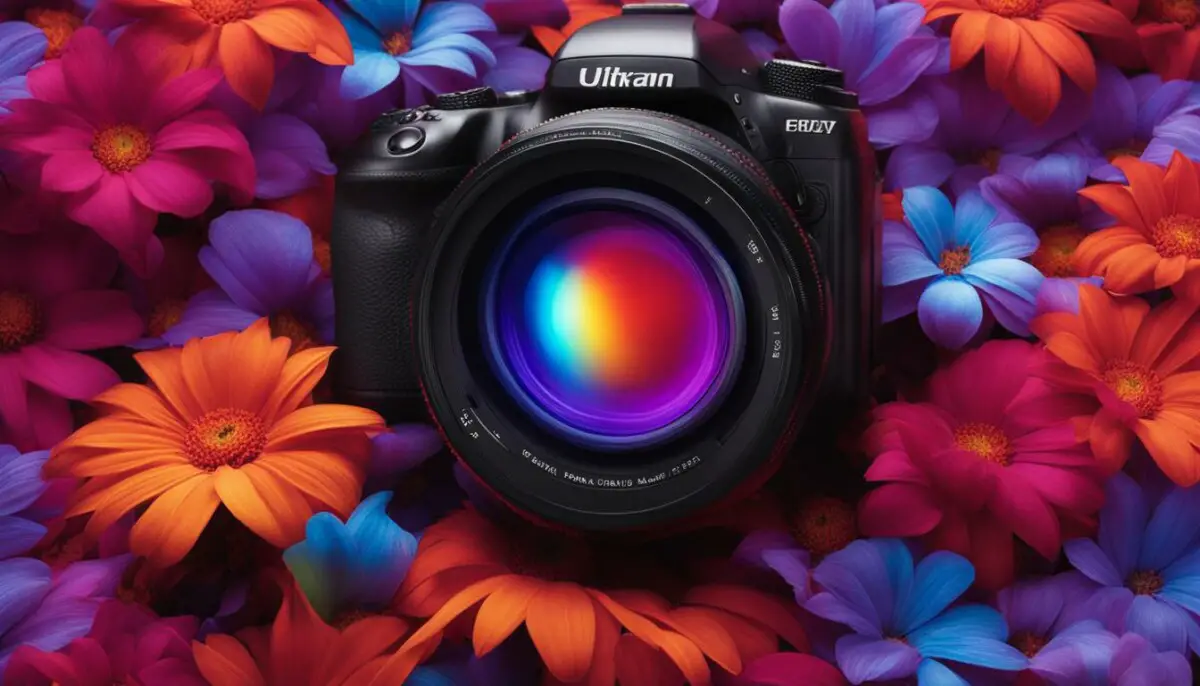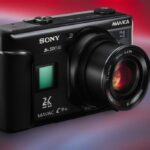Last Updated on 5 months by Francis
If you’ve ever wondered if digital cameras have the capability to see infrared and ultraviolet light, you’re in the right place! In this article, we’ll explore the fascinating world of infrared and ultraviolet photography and uncover the hidden capabilities of digital cameras.
Digital cameras, with their advanced sensor technology, have the ability to detect some ultraviolet light, all of the visible spectrum, and a significant portion of the near infrared spectrum. However, most digital cameras are equipped with an infrared hot mirror filter that blocks out most infrared and a portion of ultraviolet light. But fear not! With modifications to the camera’s filters or lens, it is possible to capture breathtaking images in infrared and ultraviolet.
Contents
Key Takeaways:
- Digital cameras can detect some ultraviolet light and a wide range of visible and near infrared light with the help of advanced camera sensors.
- The infrared hot mirror filter in digital cameras blocks most infrared and some ultraviolet light, but modifications can be made to capture these wavelengths.
- Full-spectrum photography, achieved through camera modifications, allows for the capture of a wider spectrum of light, including infrared and ultraviolet.
- Infrared and ultraviolet photography have diverse applications in various fields, such as art, forensics, scientific imaging, and even ghost hunting.
- Determining if your digital camera can see infrared is as simple as using a television remote control and observing the camera’s display screen.
How Do Digital Cameras Capture Infrared and Ultraviolet Light?

Digital cameras have the ability to capture not only the visible spectrum of light but also certain wavelengths of infrared and ultraviolet light. This is made possible through the use of camera sensors that are sensitive to a range of wavelengths, typically from about 350 nm to 1000 nm. However, digital cameras typically have an infrared filter, also known as an infrared hot mirror filter, which blocks most of the infrared light and some ultraviolet light. This filter helps to improve the image quality by reducing interference caused by infrared and ultraviolet light.
To capture infrared and ultraviolet light, photographers can modify their digital cameras by removing or replacing this infrared filter. Another option is to use specialized filters on the camera lens that allow specific wavelengths of light, such as infrared or ultraviolet, to pass through to the camera’s sensor. These modifications enable photographers to create stunning images using infrared and ultraviolet photography techniques.
“Digital cameras capture infrared and ultraviolet light through the camera’s sensors.”
Full-spectrum photography, a popular technique in this field, involves modifying cameras to capture a wider spectrum of light, including infrared and ultraviolet. This opens up a whole new world of creative possibilities for photographers, allowing them to explore unique and surreal images that are not visible to the naked eye.
The Importance of Camera Modifications
Camera modifications play a crucial role in capturing infrared and ultraviolet light. By removing or replacing the infrared filter, photographers can allow these specific wavelengths of light to reach the camera’s sensor, resulting in stunning and unique images. However, it is important to note that modifying a digital camera should be done with caution and, if unsure, it is best to seek professional assistance to avoid damaging the camera or voiding warranties.
| Infrared Photography | Ultraviolet Photography |
|---|---|
| Uses modified cameras to capture infrared light. | Uses modified cameras to capture ultraviolet light. |
| Creates unique and surreal images. | Reveals hidden details and patterns not visible to the naked eye. |
| Popular technique in art photography. | Used in various scientific and forensic applications. |
Overall, the ability of digital cameras to capture infrared and ultraviolet light opens up new creative possibilities for photographers. Through camera modifications, photographers can explore the hidden world of infrared and ultraviolet photography, capturing stunning and unique images that reveal a different perspective. Whether it’s for artistic expression or scientific research, infrared and ultraviolet photography offer exciting opportunities to push the boundaries of visual storytelling.
The History and Evolution of Infrared and Ultraviolet Photography
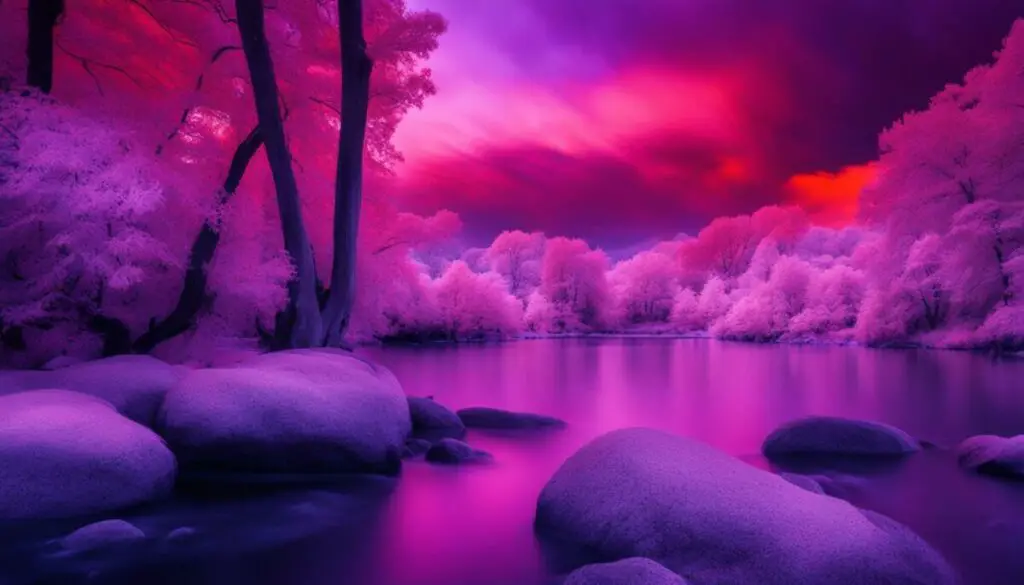
Infrared and ultraviolet photography have a rich history that spans many decades. The earliest development in this field can be traced back to the 1920s when wideband panchromatic films became available, enabling some sensitivity to ultraviolet and infrared light. As camera technology advanced, specialized films and sensors were introduced, allowing for the capture of a wider spectrum of light.
In the late 1990s, photographers began experimenting with infrared photography using digital cameras. This required modifications to remove the infrared filter, which led to the popularization of full-spectrum photography. Full-spectrum photography involves modifying cameras to capture a broader range of light, including infrared and ultraviolet. It has since become a popular technique for creating unique and captivating images.
Today, there are purpose-built full-spectrum cameras available for professional use. These cameras are designed to capture a wide range of light, from ultraviolet to infrared, allowing photographers to explore the full potential of infrared and ultraviolet photography.
Applications of Infrared and Ultraviolet Photography
Infrared and ultraviolet photography have a wide range of applications that span various fields. Let’s explore some of the most notable applications:
1. Art Photography
Infrared and ultraviolet techniques are highly sought after in the world of art photography. These techniques allow photographers to create unique and surreal images that evoke a sense of mystery and wonder. By capturing light beyond the visible spectrum, artists can convey emotions and narratives in a way that traditional photography cannot.
2. Forensics Photography
Infrared and ultraviolet imaging play an important role in forensic investigations. These techniques can reveal hidden details and enhance evidence that may not be visible to the naked eye. Infrared photography, for example, can help detect bloodstains and other substances that have been altered or cleaned. Ultraviolet photography can unveil hidden ink, fingerprints, and fibers at crime scenes.
3. Scientific Imaging
Infrared and ultraviolet photography are widely used in scientific research and study. Infrared imaging helps scientists analyze the properties of various materials, such as the heat distribution of objects or the detection of temperature differences in a scientific experiment. Ultraviolet photography is valuable in astronomy, allowing astronomers to observe celestial objects that emit or reflect ultraviolet light, providing insights into the composition and behavior of distant stars, galaxies, and planets.
“Infrared and ultraviolet photography offer unique perspectives, from capturing the ethereal beauty of landscapes to revealing hidden details in forensic investigations. These techniques have revolutionized the way we perceive the world around us.”
While some enthusiasts also use infrared and ultraviolet photography for ghost hunting, it’s important to note that scientific evidence for capturing paranormal activity is limited.
As we can see, infrared and ultraviolet photography have diverse applications, ranging from artistic expression to scientific research and forensic analysis. These techniques allow us to see beyond what the naked eye can perceive, opening up a world of possibilities and unveiling hidden secrets.
How to Determine if Your Digital Camera Can See Infrared
Curious to know if your digital camera has the ability to see infrared light? There’s a simple test you can perform using a household item – a television remote control. Here’s how:
- Find a television remote control.
- Point the remote control at your camera.
- Press a button on the remote control while looking at the camera’s display screen.
If your camera can detect infrared light, you will see a flash or a glowing spot on the display when you press the button. This indicates that your camera does not have an infrared filter and is capable of capturing infrared light. On the other hand, if nothing happens, it is likely that your camera has an infrared filter that blocks the infrared light, making it invisible to the camera.
“Performing this simple test can help you determine if your digital camera is capable of seeing infrared light, which is essential for infrared photography.”
Keep in mind that not all digital cameras have the same capabilities, and the ability to capture infrared light may vary depending on the camera model and brand. If you find that your camera cannot detect infrared light, it is still possible to modify your camera by removing the infrared filter or using specialized filters to enable infrared photography.
| Camera Reactions | Possible Interpretation |
|---|---|
| Flash or glowing spot on display | Your camera can see infrared light |
| No reaction or nothing happens | Your camera has an infrared filter that blocks infrared light |
Performing this test is a quick and easy way to determine if your digital camera is capable of capturing infrared light. Once you know the capabilities of your camera, you can explore the world of infrared photography and unleash your creativity.
How to Modify Your Digital Camera to Capture Infrared and Ultraviolet Light
Modifying your digital camera to capture infrared and ultraviolet light can open up a whole new world of creative possibilities. There are a few options available to achieve this, depending on your camera model and level of expertise. One option is to have the infrared filter removed by a professional. This involves physically opening up the camera and removing the filter, allowing the camera to capture infrared and ultraviolet light. However, this modification can be permanent and may alter the camera’s functionality.
Another option is to use infrared pass filters or wide spectrally transmitting filters on the camera lens. These filters allow only specific wavelengths of light, such as infrared or ultraviolet, to pass through to the camera’s sensor. By attaching these filters to your camera lens, you can capture stunning images in the infrared and ultraviolet range while still maintaining the ability to shoot regular photographs.
Modifying your digital camera for infrared and ultraviolet photography requires careful consideration and expertise. It is always recommended to consult professional camera technicians or experts who specialize in camera modifications to ensure proper procedures are followed and to avoid damaging your camera.
Full-Spectrum Photography and Camera Modifications
Full-spectrum photography is a popular technique that utilizes modified cameras to capture a wider spectrum of light, including infrared and ultraviolet. This involves removing or replacing the infrared filter in the camera, allowing it to capture a broader range of light. Full-spectrum photography can produce stunning and unique images, revealing details that are not visible to the naked eye.
| Camera Modification | Description |
|---|---|
| Infrared Filter Removal | Removing the infrared filter from the camera’s sensor allows it to capture infrared and ultraviolet light. This modification is permanent and cannot be undone. |
| Infrared Pass Filters | Attaching infrared pass filters to the camera lens allows only infrared light to pass through, while blocking visible light. This modification is reversible and can be used selectively. |
| Wide Spectrally Transmitting Filters | Similar to infrared pass filters, wide spectrally transmitting filters allow specific ranges of light, such as infrared or ultraviolet, to pass through. These filters can be used for capturing a broader range of light while maintaining the ability to shoot regular photographs. |
Before attempting any camera modifications, it is important to research and understand the specific requirements of your camera model. It is also advisable to consult professionals or experienced photographers who have successfully modified cameras for infrared and ultraviolet photography. By carefully considering these options and seeking expert advice, you can enhance your camera’s capabilities and explore the fascinating world of infrared and ultraviolet photography.
Using Your Smartphone for Infrared Photography
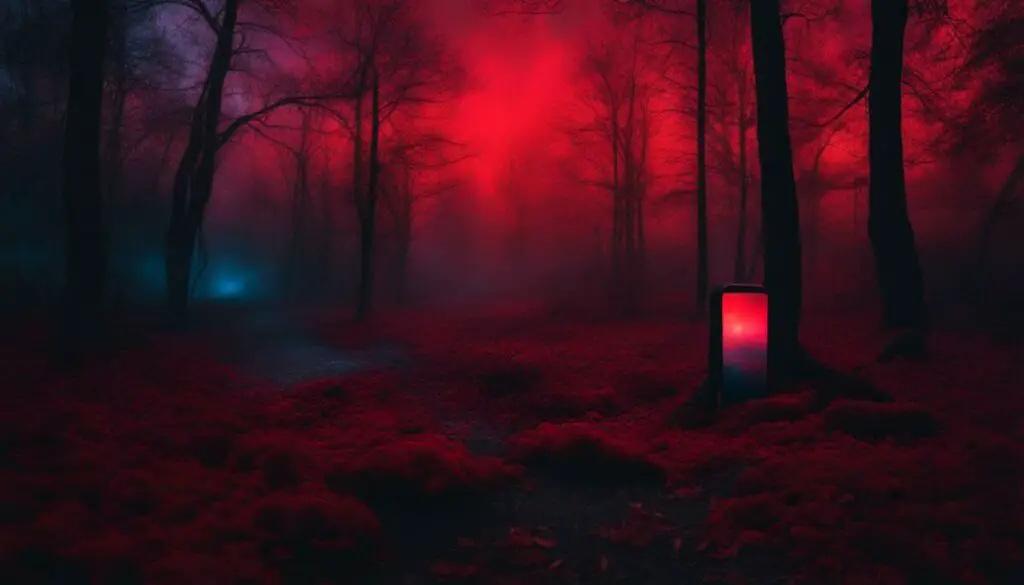
Infrared photography is not limited to dedicated digital cameras. Many smartphones have cameras that can be used to capture infrared light as well. To determine if your smartphone can see infrared light, you can follow the same testing method using a television remote control. If your smartphone can detect the infrared light, you can use it for infrared photography.
There are also camera attachments available that can convert your smartphone into an infrared camera. These attachments typically include infrared filters or lenses that allow for the capture of infrared light. They are designed to fit over the smartphone camera lens and block out visible light while allowing infrared light to pass through.
However, it is important to note that modifying your smartphone or using attachments may void warranties and should be done with caution. It’s always a good idea to research and choose reputable attachments that are compatible with your specific smartphone model. This will ensure the best results and minimize any potential risks.
Benefits of Using Your Smartphone for Infrared Photography
- Convenience: Most people carry their smartphones with them everywhere, making it easy and convenient to capture infrared images anytime, anywhere.
- Cost-effective: Smartphone attachments for infrared photography are generally more affordable compared to dedicated infrared cameras, making it a budget-friendly option for beginners and enthusiasts.
- Portability: Smartphones are lightweight and compact, making them ideal for on-the-go photography. You can explore and capture infrared images during your travels or outdoor adventures.
- Versatility: In addition to infrared photography, smartphones offer a wide range of other features and capabilities, such as editing apps and easy sharing options, allowing you to enhance and showcase your infrared images with ease.
“Using your smartphone for infrared photography opens up a world of creative possibilities, allowing you to capture unique and stunning images in the infrared spectrum. Whether you’re a professional photographer or an enthusiast, experimenting with infrared photography on your smartphone can be both fun and rewarding.”
Thermal Imaging and Night Vision with Infrared Cameras
Infrared cameras have expanded their applications beyond capturing unique and creative images. They are widely used in thermal imaging and night vision technologies, revolutionizing industries such as firefighting, search and rescue, and law enforcement. These advanced cameras can detect and visualize differences in temperature, making them valuable tools in identifying hotspots, locating missing persons, and assessing potential risks in hazardous environments.
With thermal imaging, infrared cameras can detect and display heat signatures, enabling firefighters to locate fire sources and assess the spread of flames even in smoke-filled environments. In search and rescue operations, these cameras help locate individuals by detecting their body heat, ensuring a higher chance of successful rescue missions. Law enforcement agencies utilize infrared cameras for surveillance at night, enhancing their ability to monitor and secure various environments while maintaining stealth and minimizing the need for additional lighting.
Infrared cameras are also widely used in security systems, such as CCTV surveillance. They can capture clear images in low light or complete darkness by utilizing infrared illumination. This allows for effective monitoring and surveillance in areas where traditional cameras may struggle. Similarly, game cameras, commonly used in wildlife research and hunting activities, utilize infrared technology to capture animals’ movements during the night without causing disturbances or alerting them to the camera’s presence.
| Applications | Benefits |
|---|---|
| Firefighting | Quickly identify hotspots, locate fire sources, and assess the spread of flames in smoke-filled environments. |
| Search and Rescue | Locate missing persons by detecting their body heat, increasing the chances of successful rescue missions. |
| Law Enforcement | Enhance surveillance capabilities at night, monitor secure environments, and maintain stealth operations. |
| Security Systems | Monitor and capture clear images in low light or complete darkness, ensuring effective surveillance. |
| Game Cameras | Track animal movements during the night without disturbing or alerting them. |
| Professional Applications | Examine electrical systems, locate water leaks, conduct scientific research, and more. |
In addition to these applications, infrared cameras have found extensive use in various professional fields. They are utilized for examining electrical systems to identify potential faults or overheating issues. In the construction industry, infrared cameras can detect heat loss in buildings, allowing for improved insulation and energy efficiency. In scientific research, they are employed to study the behavior of materials and analyze temperature variations in scientific experiments. The versatility and effectiveness of infrared cameras continue to expand their applications across multiple industries, showcasing their indispensable role in modern technology and advancements.
The combination of thermal imaging and night vision capabilities in infrared cameras has revolutionized the way we see and understand the world, providing valuable insights, enhancing safety, and enabling us to navigate through challenging environments with greater precision and efficiency.
Infrared and Ultraviolet Light: Beyond Photography
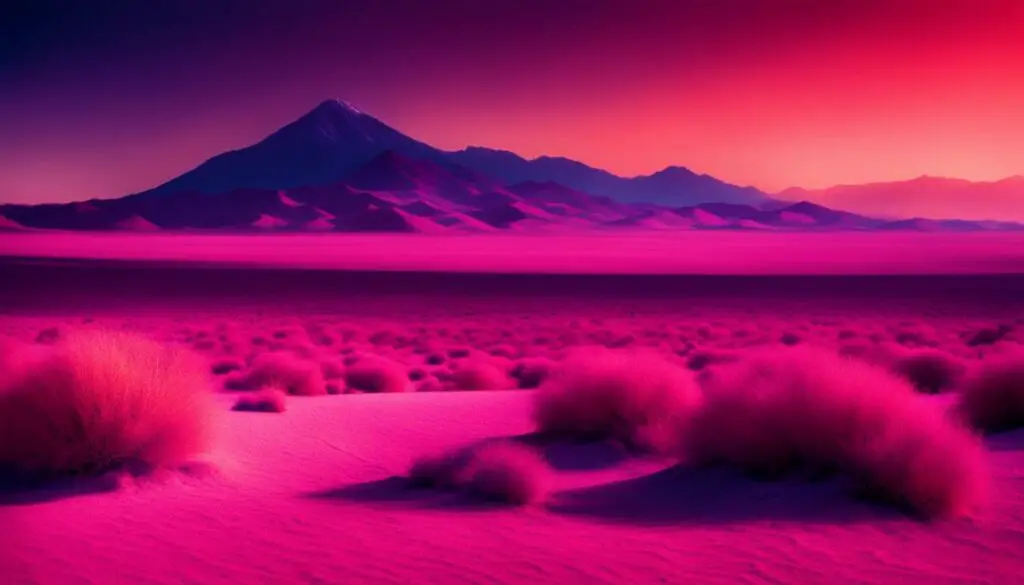
While infrared and ultraviolet light are widely known for their applications in photography, their uses extend far beyond capturing stunning images. These invisible forms of light play a crucial role in various fields, including meteorology, art restoration, astronomy, and ultraviolet sterilization.
Infrared Light in Meteorology
One of the key applications of infrared light is in meteorology. Infrared sensors are used to measure temperature variations in clouds, helping meteorologists analyze weather patterns. By detecting thermal anomalies, these sensors provide valuable insights into cloud formation, heat transfer, and atmospheric dynamics.
Art Restoration with Infrared Light
Art restoration experts employ infrared light to examine paintings and detect hidden layers of paint or alterations. By illuminating an artwork with infrared radiation, restorers can reveal underlying sketches, previous brushstrokes, and other hidden details. This technique aids in the preservation and restoration of valuable artworks.
Astronomy and Ultraviolet Light
Astronomers rely on ultraviolet light to study celestial objects that are not visible with the naked eye. Ultraviolet telescopes capture the UV radiation emitted by distant stars, galaxies, and nebulae, providing insights into their composition, temperature, and energetic processes. This data helps astronomers unravel the mysteries of the universe.
Ultraviolet Sterilization
Ultraviolet light is also utilized for sterilization purposes in various industries. UV sterilization systems are employed in water and air purification to eliminate bacteria, viruses, and other harmful microorganisms. Furthermore, UV radiation is effective in disinfecting medical instruments, food processing equipment, and surfaces in healthcare facilities.
| Field | Application |
|---|---|
| Meteorology | Measuring temperature variations in clouds |
| Art Restoration | Detecting hidden layers of paint or alterations |
| Astronomy | Studying celestial objects in the ultraviolet spectrum |
| Ultraviolet Sterilization | Eliminating bacteria and viruses in water and air |
As we can see, the uses of infrared and ultraviolet light extend far beyond photography. These invisible forms of light have widespread applications in meteorology, art restoration, astronomy, and sterilization. By harnessing the power of these invisible wavelengths, scientists and professionals continue to unlock new possibilities and make advancements in various fields.
Infrared and Ultraviolet Photography Equipment and Accessories

In order to fully explore the potential of infrared and ultraviolet photography, there is a wide range of equipment and accessories available that can enhance your photography experience. These include:
- Infrared and Ultraviolet Filters: These filters can be attached to your camera lenses to selectively filter out specific wavelengths of light. They allow you to control the amount of infrared or ultraviolet light that enters the camera, resulting in unique and creative images.
- Camera Lenses: Choosing the right lens is crucial for capturing high-quality infrared and ultraviolet photographs. There are specialized lenses available that are designed specifically for infrared and ultraviolet photography, allowing you to capture sharp and detailed images in these spectrums.
- Full-Spectrum Cameras: Full-spectrum cameras are specially designed to capture a wider range of light, including infrared and ultraviolet. These cameras are popular among professional photographers and offer advanced features and controls for achieving stunning results.
- Smartphone Attachments: If you prefer to use your smartphone for infrared and ultraviolet photography, there are a variety of attachments available that can convert your smartphone into an infrared or ultraviolet camera. These attachments typically include filters or lenses that allow for the capture of infrared or ultraviolet light.
- Thermal Cameras: Thermal cameras, also known as thermographic cameras, are specialized devices that can visualize heat patterns and temperature variations. These cameras are commonly used in various industries for thermal imaging and troubleshooting purposes.
Choosing the right equipment and accessories will depend on your specific photography needs and budget. Whether you are a professional photographer or an enthusiast, investing in quality equipment and accessories will greatly enhance your infrared and ultraviolet photography capabilities.
“With the right equipment and accessories, photographers can capture stunning images in the infrared and ultraviolet range, resulting in unique and creative photographs that stand out from the crowd.” – Photography Expert
| Equipment/Accessory | Description |
|---|---|
| Infrared and Ultraviolet Filters | Filters that selectively filter out specific wavelengths of light, allowing for control over the amount of infrared or ultraviolet light entering the camera. |
| Camera Lenses | Specialized lenses designed for capturing high-quality infrared and ultraviolet photographs, ensuring sharp and detailed images. |
| Full-Spectrum Cameras | Specially designed cameras that capture a wider range of light, including infrared and ultraviolet, offering advanced features and controls. |
| Smartphone Attachments | Attachments that convert smartphones into infrared or ultraviolet cameras, enabling infrared and ultraviolet photography using your smartphone. |
| Thermal Cameras | Specialized devices used for thermal imaging and troubleshooting, visualizing heat patterns and temperature variations. |
Safety Considerations and Precautions for Infrared and Ultraviolet Photography
When engaging in infrared and ultraviolet photography, it is essential to prioritize safety precautions to ensure the well-being of both the photographer and equipment. Here are some key considerations to keep in mind:
- Protective Eyewear: Ultraviolet light, in particular, can be harmful to the eyes and skin. Therefore, it is crucial to use appropriate protective eyewear, such as UV-blocking glasses, when working with ultraviolet sources.
- Heat Hazards: Infrared light can generate heat, and prolonged exposure to intense infrared sources can potentially cause burns or thermal injuries. It is important to avoid extended contact with such sources to minimize the risk of harm.
- Invisible Light Hazards: Both infrared and ultraviolet light are invisible to the naked eye, making it difficult to discern the presence and intensity of these light sources. Therefore, it is crucial to exercise caution and be mindful of potential hazards even when they may not be immediately visible.
- Camera Modifications: If modifying your camera for infrared photography, it is essential to follow proper procedures or seek professional assistance. Mishandling camera modifications can lead to damage or void warranties, so it is crucial to proceed with care.
“Safety should be the top priority for any photographer, especially when working with invisible light such as infrared and ultraviolet. Taking necessary precautions, such as wearing protective eyewear and avoiding prolonged exposure to intense sources, can help prevent potential injuries. Always prioritize your safety and the preservation of your equipment to ensure a smooth and enjoyable photography experience.”
By adhering to these safety precautions, photographers can confidently explore the exciting possibilities offered by infrared and ultraviolet photography while minimizing potential risks. Remember to prioritize safety, protect your eyes and skin, be mindful of heat hazards, and exercise caution when modifying your camera for these unique photography techniques.
Safety Precautions Summary
- Use protective eyewear, such as UV-blocking glasses, when working with ultraviolet sources.
- Avoid prolonged exposure to intense infrared sources to prevent burns or thermal injuries.
- Be cautious of invisible light hazards, as both infrared and ultraviolet light are undetectable to the naked eye.
- Follow proper procedures or seek professional assistance when modifying cameras for infrared photography to avoid damage or void warranties.
By following these safety measures, photographers can explore the fascinating realm of infrared and ultraviolet photography with confidence and peace of mind.
Conclusion
Infrared and ultraviolet photography offer a fascinating and creative way to explore the world of light. Through the use of digital cameras and camera modifications, photographers can capture stunning images in the infrared and ultraviolet spectrum. Whether you’re a professional photographer or an enthusiast, experimenting with infrared and ultraviolet photography can open up a whole new realm of possibilities.
Full-spectrum photography, achieved through camera modifications, allows for the capture of a broader range of light, including infrared and ultraviolet. This technique is particularly popular among artists who want to create unique and surreal images. Additionally, infrared and ultraviolet photography find applications in fields such as forensics, scientific imaging, and even ghost hunting, although the scientific evidence for paranormal activity is limited.
It is important to note that when working with infrared and ultraviolet sources, safety precautions should be considered. Infrared light can generate heat, so it is crucial to avoid prolonged exposure to intense infrared sources. Ultraviolet light, on the other hand, can be harmful to the eyes and skin, necessitating the use of protective eyewear and sunscreen.
Overall, infrared and ultraviolet photography provide exciting opportunities for photographers to capture unique and visually stunning images. While there are considerations and precautions to keep in mind, the possibilities for creative expression and scientific exploration are endless in the world of infrared and ultraviolet light.
FAQ
Can digital cameras see infrared and ultraviolet light?
Yes, modified digital cameras can detect some ultraviolet, all of the visible, and much of the near infrared spectrum. By removing the infrared filter or using specialized filters, photographers can capture infrared and ultraviolet light.
How do digital cameras capture infrared and ultraviolet light?
Digital cameras typically have an infrared filter that blocks most of the infrared light and a bit of the ultraviolet light. However, with modifications to the camera’s filters or lens, it is possible to allow the camera to capture infrared and ultraviolet light.
What is the history and evolution of infrared and ultraviolet photography?
Infrared and ultraviolet photography has a rich history dating back decades. In the late 1990s, photographers started experimenting with infrared photography using digital cameras, which sparked the interest in full-spectrum photography. Today, there are purpose-built full-spectrum cameras available for professional use.
What are the applications of infrared and ultraviolet photography?
Infrared and ultraviolet photography has applications in art photography, forensic photography, scientific imaging, and even ghost hunting. These techniques can create unique and surreal images, enhance evidence, study materials, and explore outer space.
How can I determine if my digital camera can see infrared light?
You can use a television remote control to test if your camera can detect infrared light. Point the remote control at your camera and press a button. If the camera can detect the infrared light, you will see a flash or a glowing spot on the display.
How can I modify my digital camera to capture infrared and ultraviolet light?
One option is to have the infrared filter removed by a professional. Another option is to use infrared pass filters or wide spectrally transmitting filters on the camera lens. These modifications allow for the capture of infrared and ultraviolet light while still maintaining the ability to shoot regular photographs.
Can I use my smartphone for infrared photography?
Yes, many smartphones have cameras that can be used to capture infrared light. You can test if your smartphone can detect infrared light by using a television remote control. There are also camera attachments available that can convert your smartphone into an infrared camera.
What are the applications of infrared cameras?
Infrared cameras are widely used in thermal imaging and night vision technologies. They are valuable tools in firefighting, search and rescue, law enforcement, and professional applications such as examining electrical systems and conducting scientific research.
What are the other uses of infrared and ultraviolet light?
Infrared and ultraviolet light have various other uses in meteorology, art restoration, astronomy, and sterilization purposes. In meteorology, infrared light is used to measure temperature variations in clouds. Art restoration experts use infrared light to examine paintings, and astronomers utilize ultraviolet light to study celestial objects.
What equipment and accessories are available for infrared and ultraviolet photography?
There are infrared and ultraviolet filters that can be attached to camera lenses, full-spectrum cameras designed for capturing a wider range of light, smartphone attachments for infrared photography, and thermal cameras for thermal imaging and troubleshooting.
What safety precautions should I consider for infrared and ultraviolet photography?
It is important to avoid prolonged exposure to intense infrared sources to prevent burns or thermal injuries. Protective eyewear and sunscreen should be used when working with ultraviolet sources. Proper procedures should be followed when modifying cameras to avoid damage or voiding warranties.
How can I explore the potential of infrared and ultraviolet photography?
By experimenting with modified cameras or using specialized equipment, you can capture a wider spectrum of light and discover new creative possibilities in your photography.

